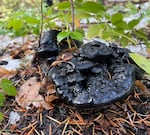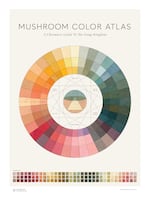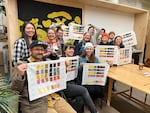“Oh wow! Look at this!” says Julie Beeler, a Trout Lake, Washington-based artist and designer as she spies a mysterious lump on the ground. “It’s Hydnellum regium!”
Beeler kneels down in an unseasonably snowy conifer grove on this October day and the enthusiasm in her voice sounds like she’s found gold nuggets on the forest floor.
Poking out just above the chilly mosses beside a small pile of elk droppings is a weird-looking mushroom commonly known as “bear poop.” As the name implies, the fungus more resembles a pile of black bear scat than a mushroom. It’s not gold, but finding it today is a treat.

The Hydnellum regium mushroom, also known as "bear poop," is a rare find in the Gifford Pinchot National Forest in Southern Washington. This one was spotted Oct. 27, 2022.
Jule Gilfillan / OPB
A few years back, Beeler and her neighbor, mycologist Michael Beug, were foraging in the area when she stumbled onto this rare member of the “tooth fungus” family.
“It had never been documented as growing this far south. It grows up in Alaska,” Beeler explains.
Unlike more familiar capped mushrooms, whose fruiting bodies produce reproductive spores from gills lining the underside of their caps, these hydnoid or tooth fungi can grow in furlike cascades, spongy shells or flowery whorls, and include more common species such as lion’s mane or hedgehog mushrooms. Hydnellum regium’s topside is a tough whorl, while its underside is made up of tooth-like structures that, like a mattress of closely clustered springs, form a velvety cushion.
But it’s not just the rarity of the mushroom that has Beeler excited.
“It’s going to create some beautiful, dark black-blue-green, some of my favorite colors. It has an intensity and a darkness to it that’s just gorgeous.”

"Strata Landscape," photographed on Jan. 17, 2023, depicts the landscapes both above and below ground. Dyes coaxed from mushrooms make up the colors of this textile art by designer Julie Beeler.
Julie Beeler / Courtesy of the artist
Beeler is one of a growing cohort of artists exploring the Pacific Northwest’s natural dyes.
She creates hand-stitched tableaus made up of appliqued swatches depicting landscapes both above and below ground. She also makes inks, pigments and watercolor paints from the mushrooms she collects. Her methodical documentation of these fungal favorites is compiled into what she calls “the mushroom color atlas,” which catalogs a variety of colors from pale pinks and corals to bold blue-greens and blacks and everything in between.

Designer Julie Beeler created the Mushroom Color Atlas to display the range of dye colors that can be coaxed from mushrooms. This was the look of the atlas as of Oct. 28, 2022.
Julie Beeler / Courtesy of the artist
“In its current form, the mushroom color atlas documents about 30 mushrooms and all the colors that are derived from them,” says Beeler. “It’s a resource and reference for people curious about mushrooms, curious about color that comes from mushrooms and how they might be inspired by that palette from the fungi kingdom.”
Beeler does sell some of the products she creates, but also spreads the gospel of using fungus-based dyes by conducting workshops and demonstrations on how to “Do It Yourself.” A workshop at WildCraft Studio School in Southeast Portland attracted a capacity crowd last December. Over the three-hour session, students dyed and cataloged ten different mushroom types, treated with different pH baths to produce their own mini mushroom color atlas.

Students at the WildCraft Studio School in Portland hold up their mushroom color charts with instructor Julie Beeler (center, in denim apron) on Dec. 8, 2022.
Jule Gilfillan / OPB
“Teaching these workshops is really rewarding because you get so many different people that are coming at this from different perspectives. But they’re all gathering around the curiosity of mushrooms and curiosity of the fungi kingdom. And you can see them start to connect and it starts to click and they unlock and then they just have this magical like, smile and enthusiasm for this world that they are now starting to learn so much more about. So, that’s always rewarding.”
For more information and links to upcoming workshops, visit the mushroom color atlas website.
